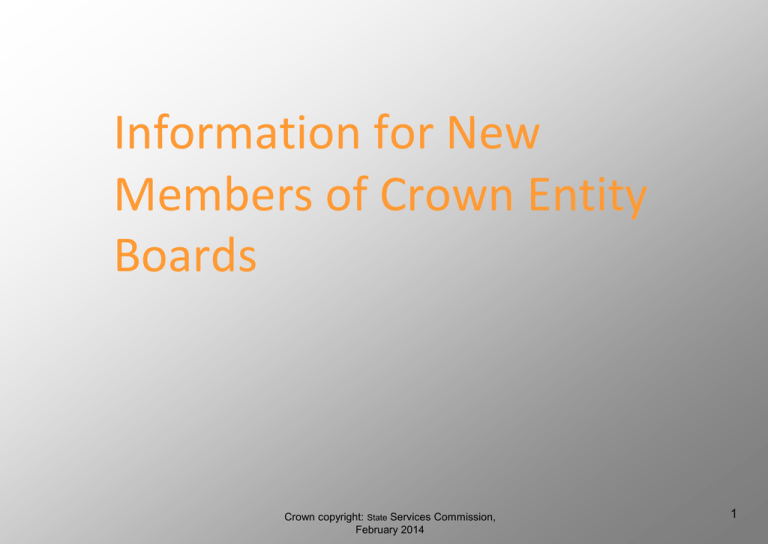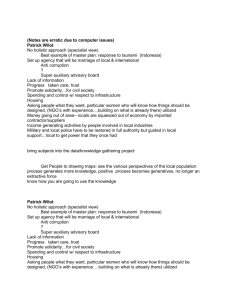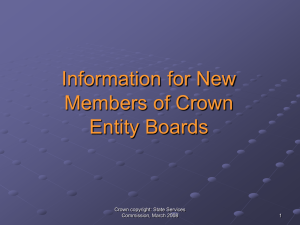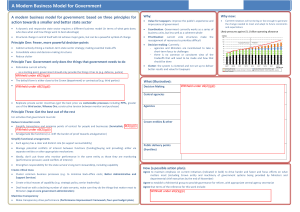Induction Programme Structure
advertisement

Information for New Members of Crown Entity Boards Crown copyright: State Services Commission, February 2014 1 1 Outline of content 1 What are Crown entities and where do they fit in the State services environment? 2 How do Ministers influence Crown entities? 3 Accountability and scrutiny of Crown entities 4 Developing effective relationships 5 Governing a Crown entity 6 Expectations of board members 7 Applying public sector values 8 Additional resources Crown copyright: State Services Commission, February 2014 2 2 Ministers influence Crown entities in various ways… Crown copyright: State Services Commission, February 2014 3 … through making board appointments • Mostly made by Ministers; ICE board members are appointed • • • • • by the Governor-General Ministers’ recommendations for appointment almost always go to the Cabinet Appointments and Honours Committee (APH) and often to the government caucus Appointments are for a fixed term Appointees may be offered a second or subsequent term of office but there is no guarantee of this Ministers and the Governor-General have powers of removal. No compensation or other benefit for loss of office Crown copyright: State Services Commission, February 2014 4 … by participating in an on-going dialogue with entities, eg.. • Meetings Ministers typically hold regular meetings with the board chair (or with senior management as authorised by the board) to discuss strategic issues. Monitoring department representatives will often be present Ministers may also have periodic meetings with the full board • Briefings Boards are expected to advise their Minister in advance of any major initiatives or developments See also ‘no surprises’ • Regular reporting Entities provide regular reports on performance to their Ministers • Informal engagement between boards and responsible Ministers contributes to more formal processes within the strategic planning and performance cycle (see over) Crown copyright: State Services Commission, February 2014 5 Strategic Planning / Performance Cycle Direction Setting What do we intend to achieve over the next 4 years and why? Identify/confirm strategy. Check indicators. Identify major areas for change. Planning Review What impact have our interventions had and what improvements can we make? Assess effectiveness and efficiency of interventions, consider unintended consequences. Continuous Improvement What is the best way to achieve this and have we got the required capability? Identify options and choose the ‘best’ intervention set. Identify required capabilities. Are we implementing and delivering as planned, and managing our capability and risks effectively? Deliver interventions, monitor and refine. Implementation and delivery Crown copyright: State Services Commission, February 2014 6 … by participating in formal strategic direction setting processes, for which there are various channels… (1) Letter of Expectations A letter of expectations may be used to set out a Responsible Minister’s expectations for: • The Crown entity’s strategic direction • Its governance and performance • Specific priorities for the planning period • Monitoring and information Crown copyright: State Services Commission, February 2014 7 (2) Statement of Intent (SOI) • The SOI is the centrepiece of the accountability relationship between a Crown entity board and its Minister (to be provided at least every 3 years as from 1 July 2014). It must cover at least four financial years • Through strategic discussions, in consultation with the Minister, a board outlines its strategic thinking and future intentions and frames its actions. A decision can then be taken as to whether a new SOI is required. • Should reflect Government’s objectives for both the sector and for individual Crown entities, and wider Government policy initiatives and themes Crown copyright: State Services Commission, February 2014 8 … through various other processes and agreements, such as … • Statement of Performance Expectations (from 1 July 2014) Details the outputs to be supplied and what they are to achieve, identifies expected revenue and proposed expenses, and explains how performance will be assessed. It is produced annually and tabled in the House • Memorandum of Understanding (MOU) May be used to document the Government’s performance expectations of a Crown entity and enable the Minister and the entity to record their understanding of the basis for monitoring, and accountability of the entity. The MOU supplements the SOI • Annual Report An assessment of performance against strategic intentions in the SOI An assessment of the performance outlined in the SPE Tabled in the House annually Crown copyright: State Services Commission, February 2014 9 … by monitoring Crown entity performance • Ministers ‘oversee and manage’ Crown entities (and are • • • • answerable to Parliament for their entities’ performance) They obtain advice from monitoring departments about the entities' effectiveness and efficiency, and how any risks will be managed Ministers can require Crown entities to supply a wide range of information They rely on good reporting from the entity and are assisted by monitoring departments as their agents Ministers are able to formally review a Crown entity’s operations and performance at any time Crown copyright: State Services Commission, February 2014 10 Ministers have powers to direct some Crown entities • Ministers may direct a Crown Agent or ACE (ie, in relation to a government policy that relates to the entity’s functions and objectives) • The Ministers of Finance and State Services may issue directions to apply a Whole of Government approach to Crown entities (eg, relating to ICT) • Ministers must consult with affected entities before issuing directions • All directions must be in writing. They are tabled in Parliament and notified in the Gazette Crown copyright: State Services Commission, February 2014 11






